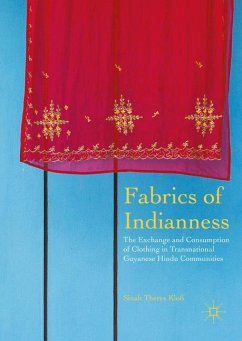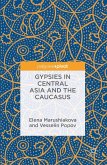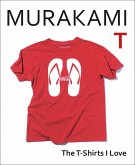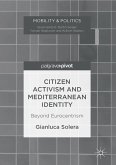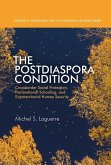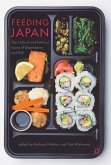Sinah Theres Kloß
Fabrics of Indianness
The Exchange and Consumption of Clothing in Transnational Guyanese Hindu Communities
Sinah Theres Kloß
Fabrics of Indianness
The Exchange and Consumption of Clothing in Transnational Guyanese Hindu Communities
- Gebundenes Buch
- Merkliste
- Auf die Merkliste
- Bewerten Bewerten
- Teilen
- Produkt teilen
- Produkterinnerung
- Produkterinnerung
This book describes how Guyanese Hindus recreate Indian ethnic identity in contemporary Guyana and examines how Hindu traditions have been transformed in this multi-religious and multi-ethnic society. By illustrating the exchange and consumption of clothing, the book demonstrates that the practices of wearing and gifting clothes materialize and visualize relationships. The significant outward migration of Guyanese to North America has resulted in substantial international gift exchange and transnational rituals. Applying the concept of translocality, this book demonstrates that different…mehr
Andere Kunden interessierten sich auch für
![Gypsies in Central Asia and the Caucasus Gypsies in Central Asia and the Caucasus]() Elena MarushiakovaGypsies in Central Asia and the Caucasus45,99 €
Elena MarushiakovaGypsies in Central Asia and the Caucasus45,99 €![Murakami T Murakami T]() Haruki MurakamiMurakami T12,99 €
Haruki MurakamiMurakami T12,99 €![Citizen Activism and Mediterranean Identity Citizen Activism and Mediterranean Identity]() Gianluca SoleraCitizen Activism and Mediterranean Identity41,99 €
Gianluca SoleraCitizen Activism and Mediterranean Identity41,99 €![The Postdiaspora Condition The Postdiaspora Condition]() Michel S. LaguerreThe Postdiaspora Condition81,99 €
Michel S. LaguerreThe Postdiaspora Condition81,99 €![Feeding Japan Feeding Japan]() Feeding Japan137,99 €
Feeding Japan137,99 €![In Paris In Paris]() Jeanne DamasIn Paris15,99 €
Jeanne DamasIn Paris15,99 €![Fake Meds Online Fake Meds Online]() Alexandra HallFake Meds Online41,99 €
Alexandra HallFake Meds Online41,99 €-
-
-
This book describes how Guyanese Hindus recreate Indian ethnic identity in contemporary Guyana and examines how Hindu traditions have been transformed in this multi-religious and multi-ethnic society. By illustrating the exchange and consumption of clothing, the book demonstrates that the practices of wearing and gifting clothes materialize and visualize relationships. The significant outward migration of Guyanese to North America has resulted in substantial international gift exchange and transnational rituals. Applying the concept of translocality, this book demonstrates that different localities continue to influence transnational networks and socio-cultural practices. It provides a study of migration that emphasizes various aspects of material and visual closeness, conceptualizing the notion of touch.
Produktdetails
- Produktdetails
- Verlag: Palgrave Macmillan / Palgrave Macmillan US / Springer Palgrave Macmillan
- Artikelnr. des Verlages: 978-1-137-56540-2
- 1st ed. 2016
- Seitenzahl: 332
- Erscheinungstermin: 10. August 2016
- Englisch
- Abmessung: 216mm x 153mm x 23mm
- Gewicht: 564g
- ISBN-13: 9781137565402
- ISBN-10: 1137565403
- Artikelnr.: 44570401
- Herstellerkennzeichnung Die Herstellerinformationen sind derzeit nicht verfügbar.
- Verlag: Palgrave Macmillan / Palgrave Macmillan US / Springer Palgrave Macmillan
- Artikelnr. des Verlages: 978-1-137-56540-2
- 1st ed. 2016
- Seitenzahl: 332
- Erscheinungstermin: 10. August 2016
- Englisch
- Abmessung: 216mm x 153mm x 23mm
- Gewicht: 564g
- ISBN-13: 9781137565402
- ISBN-10: 1137565403
- Artikelnr.: 44570401
- Herstellerkennzeichnung Die Herstellerinformationen sind derzeit nicht verfügbar.
Sinah Theres Kloß is Postdoctoral Researcher at the Global South Studies Center, University of Cologne, Germany, and Research Fellow at the Center for Religion, Economy and Politics at the University of Basel, Switzerland. She is co-editor of Caribbean Food Cultures: Culinary Practices and Consumption in the Caribbean and Its Diasporas.
Chapter 1: Guyanese Hinduism and the Study of Clothing: An Introduction.- Socio-historical Context and Religious Groups in Guyana.- Guyanese Hindu Traditions.- Guyanese Transnationalism and the Concept of Translocality.- Methodology.- The Study of Clothing and Dress.- Clothing, Closeness, and Migration.- Outline of the Book.- Resemblance, Imitation, and Consumption.- Intimacy, Touch, and Exchange.- Chapter 2: Negotiating 'Indianness' Through Indian Wear.- Defining 'Indian Wear'.- The Ambiguous 'Long Skirt'.- Dressing Up for Puja.-Indian Wear and Ethnic Identity.- Indian Ethnic Identity and the African 'Other'.- Indian Revitalization.- Nuh-propriate Clothes and the Influence of Bollywood Movies.- Contested Indianness.- The 'Indian Indian' as Indian 'Other'.- Indo-Caribbeanness.- Mastering the Sari: Dress and the Performance of Indianness.- Degrees of Indianness?.- Chapter 3: Stitching Readymade Dhotis: The Social History of Indian Wear in Guyana.- 'Overseas Clothing'.- Selfmade Clothes and Indian Wear.- Branding 'Foreign' Status.- Stitching Authority?.- 'Superior' Dress, Conversion, and Social Upward Mobility.- Dressing Respectably: Dress Codes and Draped Clothes.- Adapting English Wear: White Dresses and Orhni.- Hindu Male 'Effeminacy' and Indian Wear.- Stitching Dhotis.- Chapter 4: Uniform(ity) Through Color: The Invention of Madrassi Vestment.- The 'Invention' of the Madras Tradition.- Processes of Standardization.- Creating Madras 'Authenticity'.- Creating the Garment.- The 'Invention' of Vestment.- Uniform(ity).- Contested Discipline.- Unifying Color.- The Stigma of Being Madrassi.- Chapter 5: (Ex)Changing the Deity's Clothes.- "Cyan leff a God naked": Dressing the Deity.- Matching Murti Clothes.- The Practice of Charhaway.- "Give fromyour brows, your sweat".- The Joint Family as Contributor.- Sending Ritual Contributions.- Photographs as Substitutes.- Sharing Mudda's Saris.- Barrel-sending in a Madrassi Community.- Wearing Mudda's Clothes.- Chapter 6: Staying in Touch, Dwelling in Clothes: Barrels, Gift-Giving, and Migration.- To 'Send Back' Gifts.- Barrel-sending and the Exchange of Clothing.- The Barrel as Joint Effort.- Giving Used Clothes.- Clothing as Dwelling Structure.- Bodies and Clothing in Exchange.- Contact and Touch'Physical' and 'Spiritual' Bodies.- Throwing Spirits Pon Clothes.- Energies and Substances.- Used Clothing as Memory and Presence.- Chapter 7: Touched Clothes and Thrifty Barrels.- Giving as Consumption.- Touched Clothing'Nation' and Caste Identities.- New and Used, Clean and Polluted.- Wearing Prasadam.- Cleaning Bodies, Washing Clothes.- Barrels and Thrift.- Gifts ofUsed Clothing as Disposal?Sending Thrifty Barrels.- In Guyana, "Things Finish So Fast".- Thrift and Indian Identity.- 'Recycling' Used Clothes:Thrifty and Wasteful Disposal.- Chapter 8: Conclusion.
Chapter 1: Guyanese Hinduism and the Study of Clothing: An Introduction.- Socio-historical Context and Religious Groups in Guyana.- Guyanese Hindu Traditions.- Guyanese Transnationalism and the Concept of Translocality.- Methodology.- The Study of Clothing and Dress.- Clothing, Closeness, and Migration.- Outline of the Book.- Resemblance, Imitation, and Consumption.- Intimacy, Touch, and Exchange.- Chapter 2: Negotiating 'Indianness' Through Indian Wear.- Defining 'Indian Wear'.- The Ambiguous 'Long Skirt'.- Dressing Up for Puja.-Indian Wear and Ethnic Identity.- Indian Ethnic Identity and the African 'Other'.- Indian Revitalization.- Nuh-propriate Clothes and the Influence of Bollywood Movies.- Contested Indianness.- The 'Indian Indian' as Indian 'Other'.- Indo-Caribbeanness.- Mastering the Sari: Dress and the Performance of Indianness.- Degrees of Indianness?.- Chapter 3: Stitching Readymade Dhotis: The Social History of Indian Wear in Guyana.- 'Overseas Clothing'.- Selfmade Clothes and Indian Wear.- Branding 'Foreign' Status.- Stitching Authority?.- 'Superior' Dress, Conversion, and Social Upward Mobility.- Dressing Respectably: Dress Codes and Draped Clothes.- Adapting English Wear: White Dresses and Orhni.- Hindu Male 'Effeminacy' and Indian Wear.- Stitching Dhotis.- Chapter 4: Uniform(ity) Through Color: The Invention of Madrassi Vestment.- The 'Invention' of the Madras Tradition.- Processes of Standardization.- Creating Madras 'Authenticity'.- Creating the Garment.- The 'Invention' of Vestment.- Uniform(ity).- Contested Discipline.- Unifying Color.- The Stigma of Being Madrassi.- Chapter 5: (Ex)Changing the Deity's Clothes.- "Cyan leff a God naked": Dressing the Deity.- Matching Murti Clothes.- The Practice of Charhaway.- "Give fromyour brows, your sweat".- The Joint Family as Contributor.- Sending Ritual Contributions.- Photographs as Substitutes.- Sharing Mudda's Saris.- Barrel-sending in a Madrassi Community.- Wearing Mudda's Clothes.- Chapter 6: Staying in Touch, Dwelling in Clothes: Barrels, Gift-Giving, and Migration.- To 'Send Back' Gifts.- Barrel-sending and the Exchange of Clothing.- The Barrel as Joint Effort.- Giving Used Clothes.- Clothing as Dwelling Structure.- Bodies and Clothing in Exchange.- Contact and Touch'Physical' and 'Spiritual' Bodies.- Throwing Spirits Pon Clothes.- Energies and Substances.- Used Clothing as Memory and Presence.- Chapter 7: Touched Clothes and Thrifty Barrels.- Giving as Consumption.- Touched Clothing'Nation' and Caste Identities.- New and Used, Clean and Polluted.- Wearing Prasadam.- Cleaning Bodies, Washing Clothes.- Barrels and Thrift.- Gifts ofUsed Clothing as Disposal?Sending Thrifty Barrels.- In Guyana, "Things Finish So Fast".- Thrift and Indian Identity.- 'Recycling' Used Clothes:Thrifty and Wasteful Disposal.- Chapter 8: Conclusion.

